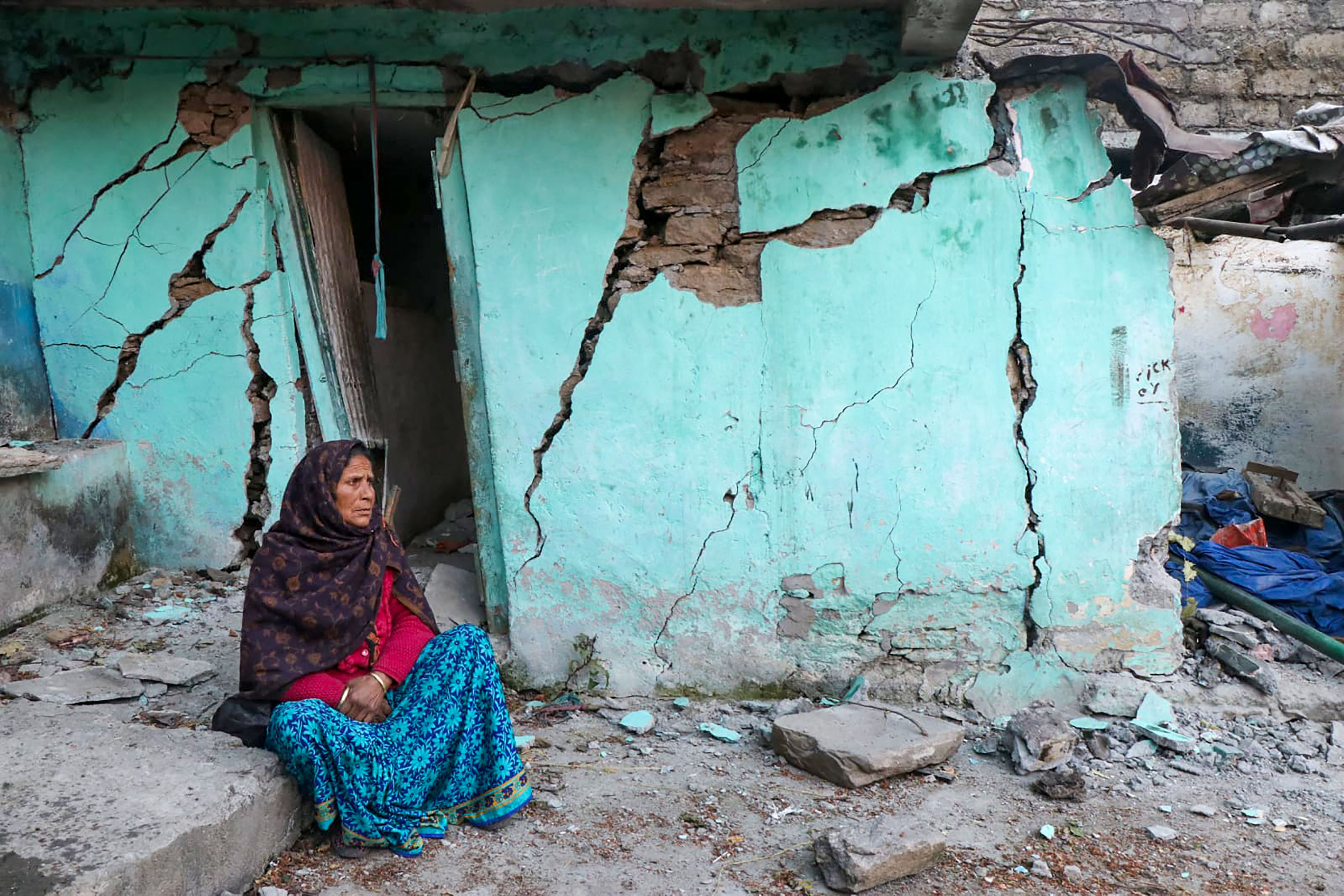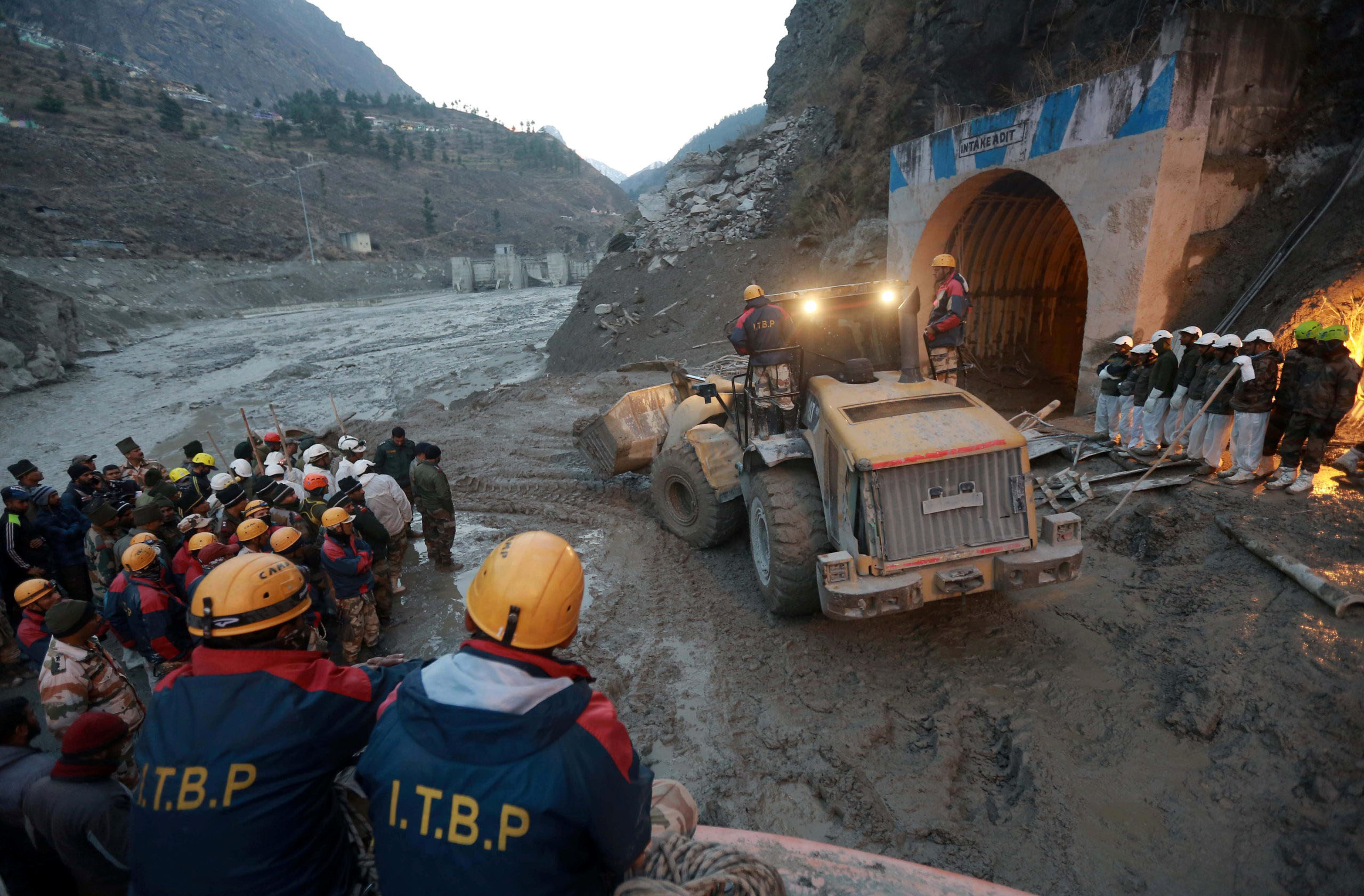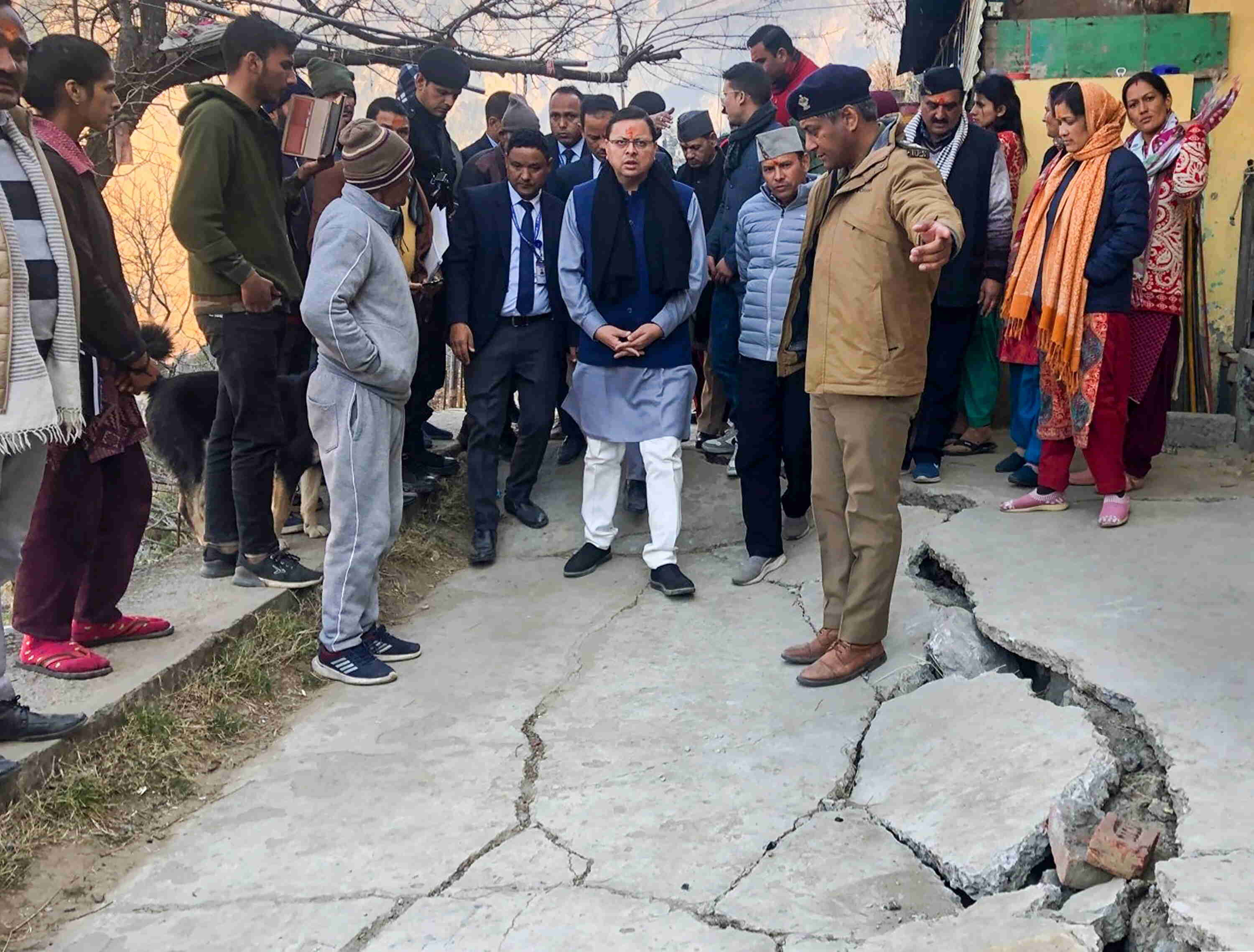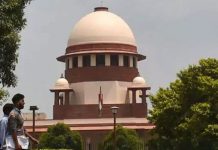
Residents of Joshimath stare at an uncertain future after the ancient town suddenly developed cracks affecting households and streets in 40 pc of its area. Multiple governments’ failure to pay heed to the repeated expert warnings has brought the town to this pass, writes Mudit Mathur
The ancient township of Joshimath – inhabited on the dip slopes of Alaknanda River at the confluence of Dhauliganga river (at an altitude of over 6,107 feet) has suddenly redeveloped cracks in the households, streets and retaining walls affecting around 40 percent of the area. In view of unforeseen mishap due to the unstoppable deteriorating situation on grounds, more than 725 residential houses, many hotels and public utilities are being evacuated that developed dangerous cracks in the walls, floors and roofs affecting thousands of the town’s residents. The administration ordered demolition of two hotels which have dangerously dislocated after developing major cracks besides declaring around hundred houses uninhabitable.
The National Crisis Management Committee (NCMC) in New Delhi reviewed the situation of Joshimath and stressed that the immediate priority should be to ensure complete and safe evacuation of all residents in the affected zone. At a meeting of the NCMC, Cabinet Secretary Rajiv Gauba stressed that priority should also be accorded to the demolition of vulnerable structures where cracks have appeared in a safe manner. Local residents are resisting demolition attempts by disaster management groups deployed there and demanding compensation of their investments in hotels and households that have been declared unsafe.
Similar reports of cracks and land sinking are pouring in from Karnaprayag and adjoining areas, indicating an impending disaster in our strategic Hindu-Kush Himalayan range ––connecting international borders –– as these are just man-made crisis resulting from over exploitation of nature against the scientific warnings in these seismic zone areas. Cracks appeared in around 50 houses and various minor landslides have also taken place in Bahuguna Nagar of Karnprayag. The local municipality has requested Chief Minister Pushkar Singh Dhami for immediate government help. This comes amid the issue of land subsidence in Joshimath.

The Uttarakhand Chief Minister Pushkar Singh Dhami on January 11 air dashed to Joshimath for a night stay and met grief-stricken people assuring them all help and support of his government. He promised to rehabilitate homeless people who lost all their belongings due to severe damage to their properties. He asserted that his policy would be to have a balance between ecology and economy. An amount of Rs 1.5 lakh is being given as interim assistance to each affected family.
“Our government is taking full care of the interests of the local people. The local people who have been affected by the landslide will be compensated at the market rate. The market rate will be decided after taking the suggestions of the stakeholders and will be in public interest only,” Dhami announced.
The Uttraakhand government after due assessment of the ground situation declared all the nine municipal wards of this ancient pilgrimage town of Hindu religion, known as Jyotirpeeth, where Aadi Sankaracharya underwent austerity, as “landslide-subsidence zone” (ground sinking) under the Disaster Management Act.
Despite freezing cold conditions, thousands of homeless people are on the streets to protest against the government’s policies and over uncertainty of their rehabilitation and future livelihood. The tragedy-hit people demand compensation and aid from state and district authorities to help mitigate the losses and find solution to the major problem of them having been rendered homeless.
Joshimath in Chamoli district of Uttarakhand is the gateway to famous pilgrimage sites like Badrinath Dham, Tung Nath, Hemkund Sahib, Chopta, Valley of Flowers and international skiing destination of Auli for winter sports. The place became strategically important after the 1962 Indo-China war with many of its territories bordering China and Tibet. Since then, it has been a strong base of the Indian Army and Indo-Tibetan Border Police (ITBP). Therefore, the need to cater logistics at Joshimath was quite natural but successive governments failed to develop the structural township in accordance with an eco-sensitive well-planned master plan providing quality infrastructure of drainage, sewage and water supply system.
In October 2021, residents of the town’s Gandhinagar and Sunil wards started noticing cracks in their houses. By mid-2022, cracks also appeared in the Ravigram ward. The situation came to this pass because the successive governments ignored warnings of numerous committees of experts constituted for assessment of environmental impact in the wake of commissioning of various hydro-power and road development projects including flagship all-weather road project of the BJP government that uprooted thousands of trees after apex court allowed the project.
One of the Hindu monasteries, the Shankaracharya Math in Joshimath area, has also developed cracks in many places over the past 15 days, triggering a scare in the religious institute. Perturbed over the government’s inaction and panic in local people, Swami Avimukteshwaran Saraswati of the Math has approached the Supreme Court of India through a Public Interest Litigation over the recent land sinking incidents in Joshimath. The PIL urged to declare Joshimath land sinking as a National Disaster and direct the NDMA to actively support the residents of Joshimath. Chief Justice of India Dr DY Chandrachud did not grant early hearing and will hear the matter on 16th January.
The high-powered committee on the all-weather Char Dham Road headed by Ravi Chopra, which was formed in August 2019, had red-flagged construction of a Helang bypass in its report. However, after the matter went to court, the Supreme Court in May 2022 gave permission to go ahead with this stretch. Chopra, while reacting to the latest decision on stopping these crucial works, said, “This was necessary. Before any work is started on this stretch connecting Badrinath Dham, the BRO must conduct detailed and careful geological, geophysical and geotechnical analysis as recommended earlier by the high-powered committee. So far, that detailed investigation has not been done,” he remarked in conversation with media persons.
Overlooking geo-scientific reports and the threat of increasing global warming on glaciers, the successive governments have played havoc on the poor people of the town with their properties acquired by spending their lifelong savings facing a grave danger now. Hundreds of houses, hospitals, Army establishments, temples, roads are under a continuous threat of sinking which is aggravating with each passing day.
Initial studies about fragile slopes of Joshimath were done after Heim and Gansserway way back in 1939 noticed that Joshimath town is situated on an old landslide deposit. According to them, the slopes dominated by massive boulders between Joshimath and Tapovan were triggered by a landslide in the geological past from a mountain crest located at 4000 m in the east of Kuari pass.
These slopes were subsequently inhabited in the historical period as they provided required soil cover for agriculture, vegetation for fuel and fodder. Most importantly, the multiple streams and natural springs having the recharge area in the upper alpine catchment provided much needed water for irrigation and domestic consumption. Instead of accepting the geological fragility, the town began to grow rapidly after 1962 due to various urgent strategic requirements.
The threat of sinking had always been there. The incidences of landslide-subsidence drew serious concerns of the Uttar Pradesh government too which constituted a committee to investigate the causes of land subsidence under the then Commissioner of Garhwal region, Mahesh Chandra Mishra on 8th April 1976. The Mishra committee held a detailed deliberation with all the stakeholders including famous environmentalist of Chipko movement, Chandi Prasad Bhatt, Purshottam Billangwal, President, Zila Panchayat, Govind Singh Rawat, Puran Singh Mehta of Badrinath temple, District Magistrate Bhure Lal, Army, ITBP, Forest, PWD and conducted extensive survey of the areas. The Mishra Committee gave detailed recommendations to the government of UP but most of them remained on paper until the problem took a serious turn.
The major recommendations of the Mishra Committee included (i) Further construction in the area should be made only after examining the stability of the site and restriction should be placed on excavation on slopes. (ii) No boulders should be removed either by digging or blasting and no tree should be cut in the landslide zone. Extensive plantation work should be launched in the area particularly between Marwari and Joshimath and the cracks, which have developed on the slopes, should be sealed. (iii) Most importantly, on the foot hill hanging boulders should be provided with appropriate support and anti-scour or river training measures should be adopted. It was also emphasized that there should be a blanket ban on collecting construction material from a radius of 5 km of the Joshimath town.
The Mishra committee precisely pointed out in its report that the major threats posed to the fragile slopes of Joshimath is the unregulated disposal of waste water (without proper drainage), removal of landslide boulders for construction purposes (building and roads), lack of anti-scour or river training measures etc. The report also pointed out that undercutting by the currents of the Alaknanda River makes the area even more prone to disasters. These suggestions still hold good for the safety, security and longevity of Joshimath and surrounding villages but unfortunately the recommendations have yet not caught the attention of the government.
However, in the process, the stability of the surface on which the town was emerging was totally ignored. It was only during the late 60s that the concern about the safety and stability of the town became an issue. This led to the timely intervention by the then government and a scientific committee was constituted to provide suggestions about the stability of the town.
Undoubtedly, Joshimath is a victim of government apathy that resulted in unplanned growth of real estate activities without taking due care of ecology with regard to its stability and load bearing capacity, sewage and drainage system and rainwater disposal system that further intensified dip slopes related issues. These are built on land that is either unstable or could be easily washed away in the event of a flash flood. The area also failed to grow extensive tree plantations as recommended by the Mishra Committee. Rather, deforestation due to unbridled construction activities resulting in depletion of its green cover multiplied its problem.
Local residents blame that repercussion being experienced even now after the last year’s tragedy when a major disaster happened killing more than two hundred people due to glacier burst happened in Nanda Devi Mountain range resulting in unprecedented deluges in Tapovan region, just at the base of Joshimath where NTPC is executing 520 MW Tapovan–Vishnugad Hydro-Power Project by making four-km long stretch of tunnels.
Environmentalists allege that the NTPC project had hollowed and damaged the underground layers of earth devastating its age-old natural drainage, ecology and water supply system. The project being constructed on the Dhauliganga river required a tunnel to be built that cut right through the mountain upon which Joshimath is located. Meanwhile, the Helang bypass road under flagship all-weather Char Dham Road project to cut short the distance of Badrinath Dham directly from its base has also become counter-productive for the holy township.
The Tapovan region event is feared to have triggered the current “sinking and cracking,” according to experts. In October that year, Joshimath experienced an unusual torrential downpour of over 190 mm. After the rains, residents noticed a movement in the cracks and more frighteningly, the appearance of new cracks as well, with several cropping up inside homes.
The noted geologist, Navin Juyal warned, in a webinar held early this month: “The historic town of Joshimath in Uttarakhand will be washed out if the under-construction Tapovan-Vishnugad Hydropower Project of National Thermal Power Corporation (NTPC) as well as the Helang Bypass project are not shelved.” Juyal’s warning sounds ominous amid continuing panic which has gripped the Joshimath town of Chamoli district, where cracks have appeared in over 725 houses as the town sinks due to land subsidence.
“Two tunnels are being dug as part of the Tapovan-Vishnugad Hydroelectric Project. One is being dug from Tapovan and the other from Selang. For this, tunnelling is being done from one side by blasting and on the other with a Tunnel Boring Machine (TBM) from Selang. The TBM is still stuck in Selang. This work is being done by a private company due to which the situation has worsened,” Juyal opined. “The NTPC has argued that the tunneling has been done only up to four kilometers from Tapovan. But when it comes to studying the activity, independent scientists have been kept away,” he contended.
“Despite the warnings from experts and geoscientists, no heed was paid while undertaking works of road and dam construction in and around Joshimath,” said convenor of Joshimath Bachao Sangharsh Samiti, Atul Sati, who, along with other residents, has been continuously protesting the construction of NTPC’s 520 MW Tapovan Vishnugad hydropower project since 2004. “The project,” he said, “is the root cause behind land sinking in Joshimath, where construction activities were recommended to be banned.”
“We have been drawing the attention of authorities for the past 14 months but the government did not pay any attention. Now when the situation is getting out of hand, they are sending expert teams to assess things,” Sati remarked. “If attention was paid in time to what we were saying, things would not have been so alarming in Joshimath today,” he added.

In May 2010, two researchers from Garhwal University and Disaster Mitigation Management Centre, MPS Bisht and Piyoosh Rautela, wrote a commentary in the journal Current Science highlighting the risks that the town is facing. They reported that the government should not have overburdened the town through the tunnel alignment which was part of the hydropower project. It further recorded finding that the tunnelling process punctures the water-bearing strata and causes harm with water gushing out and flooding the area.
Dr Piyoosh Rautela has now become the executive director of Uttarakhand Disaster Mitigation and Management Centre of the Uttarakhand government, and interestingly, with his changed role, there is some shift in his stance regarding the present crisis. “The sinking of Joshimath is likely to have been caused by aquifer (a water-bearing stratum of permeable rock, sand, or gravel) breaches as we see muddy waters pouring out,” he said. However, he remained non-committal to his earlier findings saying, “There is no evidence yet to link or delink it with the hydro project tunnel.”
The NTPC issued a press release denying any role of its tunnel in triggering the sinking of land. But local residents and few independent experts firmly believe the water that has continued to be released through the puncture may have added to land subsidence.
Geologist Yaspal Sundriyal from Hemvati Nandan Bahuguna (HNB) Garhwal University said, “The road is impacting the very foundations on which Joshimath is built, and may worsen the town’s proneness to landslides.”
Earlier reports suggest that the tunnel boring machine (TBM) being used in Tapovan Vishnugad project punctured an aquifer (a water-bearing stratum of permeable rock, sand, or gravel) over 3 km from Selang village, resulting in water discharge at the rate of about 700-800 litres per second which is enough to sustain 2-3 million (20-30 lakh) people. “Soon after the incident, groundwater sources in Joshimath started drying up. Sunil Kund, which was a major freshwater source here, suddenly went dry.” While the discharge reduced over time, it never stopped completely,” said Joshimath-based advocate and journalist, Puran Billangwal.
While the alarm bells have been ringing for a long time, there is still some hope for saving Joshimath if the proper measures are implemented. The residents need to be relocated to a safer place and the administration would have to re-plan the town in a geo-scientific manner factoring in the on-going climate change in Himalayan range. The developmental and hydroelectric projects also need to be shelved by accepting the recommendations to save hills.












